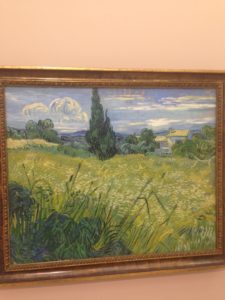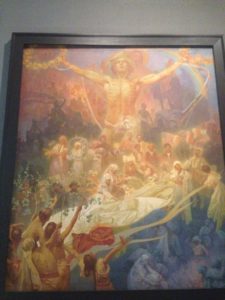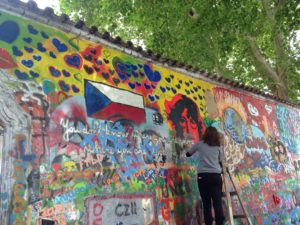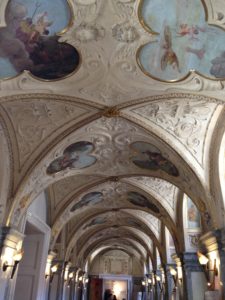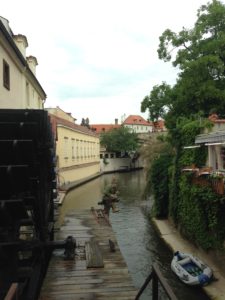Prague's Quiet Side
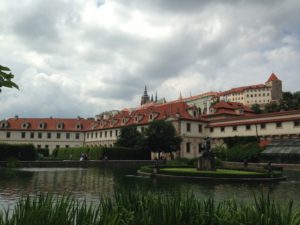 While Prague is filled with beautiful buildings, fantastic cultural sights, and great restaurants, its main quarters are also teeming with crowds of tourists. In Prague’s Old Town, you are more likely to see signs in English than Czech amid the ambling groups of English and French grandmothers. These tourists have come for good reason: Prague and its historic center especially are undeniably rich in culture and beauty, with so many interesting sights. However, the ambiance slightly resembles a European Disneyworld. With its vendors selling ‘I heart Prague’ t-shirts and the ubiquitous sweet Trdelnik rolls (absolutely get one if you go, they’re delicious), Prague’s main areas make it hard to find the time to collect your thoughts and relax.
While Prague is filled with beautiful buildings, fantastic cultural sights, and great restaurants, its main quarters are also teeming with crowds of tourists. In Prague’s Old Town, you are more likely to see signs in English than Czech amid the ambling groups of English and French grandmothers. These tourists have come for good reason: Prague and its historic center especially are undeniably rich in culture and beauty, with so many interesting sights. However, the ambiance slightly resembles a European Disneyworld. With its vendors selling ‘I heart Prague’ t-shirts and the ubiquitous sweet Trdelnik rolls (absolutely get one if you go, they’re delicious), Prague’s main areas make it hard to find the time to collect your thoughts and relax.
During my days in Prague, I tried to balance soaking in the historical center and finding more isolated places to contemplate the beauty of the city. After spending a morning at Prague’s fantastic Castle, I took the tram out to the Veletrnzni Palac, the Czech Republic’s National Art Gallery which houses works of modern Czech and European art.
Inside this Soviet-era, unremarkable building in an outer neighborhood are the canvases of Alphonse Mucha’s Slav Epic. Mucha, one of the Czech Republic’s greatest artists and pioneer of Art Nouveau styles, created 20 huge canvases depicting the historical journeys of the Slavic peoples, culminating in the Czech Republic’s independence in 1918. When I began my tour I was almost completely alone as I walked through excellent displays of modern art. Among the 30-foot high canvases of the Slav Epic, I was able to concentrate on the alluring power of his art in a way impossible among the crowds of other, better known museums.
The next morning, I explored the lesser known side of Prague’s Little Quarter by first visiting the John Lennon wall, a mural of messages of peace and hope that started as a memorial to Lennon and a means of opposition to the Communist regime. Today many crowd in front of it in what may seem kitschy posing, but on reflection I found it touching that people still find inspiration in that art.
Just a few steps from the Lennon wall is Kampa island, a small island in the Vlatva river separated by a small canal that contains several shops and a quiet park. I took some moments to rest on a bench and calmly watch the park-goers enjoy the day, listening to the jaunty music of a piano set up in the grass. Kampa Island offers a respite, a pause in the darting through crowd and navigating twisting medieval streets, under its green trees and by its whispering brooks. On the island, I watched the tourists with tranquility, no longer seeing them as annoyances but just as another aspect of Prague itself.
In same neighborhood, as I walked up the hill towards the Castle district, I saw a door leading into the Wallenstein Palace and garden, where the Czech Senate now meets. The Palace also features an exquisite garden open to the public. As I luckily had come in on a Sunday, I also got to see some of the greeting chambers of the old palace used by the Senate, which stunned me with their ornate beauty. In the gardens, fountains bubble while peacocks stride between the bushes, and from the benches excellent views of the Prague Castle can be seen. Although there were a good number of people visiting the garden, the peacefulness of the place created a kind of quiet and satisfaction in the beauty all around us. The Wallenstein Palace offers a glimpse in a past and I found quietude there by imagining its historical glamour and getting lost in the moment.
As a lone traveler, it was important to me not only to see the sights but also to rest and find time to think by myself. I found I was at my happiest when I could relax in solitude, put everything I saw into context, and just enjoy the passing of time. Despite its hectic streets and touristy atmosphere, Prague still has wonderful hideaways to do just that. On your travels, find the places that let you be yourself, and you’ll enjoy it that much more.

